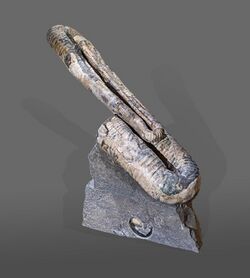Biology:Polyptychoceras
| Polyptychoceras | |
|---|---|

| |
| Subptychoceras yubarense | |
| Scientific classification | |
| Domain: | Eukaryota |
| Kingdom: | Animalia |
| Phylum: | Mollusca |
| Class: | Cephalopoda |
| Subclass: | †Ammonoidea |
| Order: | †Ammonitida |
| Suborder: | †Ancyloceratina |
| Family: | †Diplomoceratidae |
| Genus: | †Polyptychoceras Yabe, 1927 [1] |
| Species | |
| |
Polyptychoceras is an extinct genus of ammonites from the Late Cretaceous of Asia, Europe, and North[2] and South America. It was first named by Hisakatsu Yabe in 1927.[3]
Species and subspecies
This genus contains the following eight species and one subgenus, Subtychoceras, which contains one species.[3]
- Polyptychoceras mihoense
- Polyptychoceras pseudogaultinum, could reach a length of 100 – 120 mm[3]
- Polyptychoceras haradanum (Yokoyama)
- Polyptychoceras obatai
- Polyptychoceras obliquecostatum
- Polyptychoceras subunduratum
- Polyptychoceras obstrictum (Jimbo)
- Polyptychoceras vancouverensis, located around the Trent and Puntledge Rivers.[2] Due to its shape, fossil poachers often call it the "paperclip ammonite" or "candy cane".[2]
- Polyptychoceras (Subptychoceras) yubarense, could reach a maximum length of 200 mm[3]
Description
Polyptychoceras is a heteromorph ammonite, meaning that its shell does not curl up into the tight spiral shape which shells of ammonites from the subclass Ammonoidea typically do.
Polyptychoceras shells have an abrupt weight increase after formation of the initial shaft, which represents the shell's automatic balance condition.[4] This would have caused the shell to topple over if on land.[4] The soft body of the animal would have to have been large, in order to keep the falling shaft off of the ground.[4] The body would not have been resistant to the pressing shell.[4]
Although the shafts in the fossils of the shells are usually parallel to each other, small aberrations during each growth stage often caused abrupt constrictions in the shape of the shell.[5]
Life
A Japanese study in 1979 suggested that Polyptychoceras lived and travelled in schools, similarly to modern cuttlefish.[3] Individual fossil specimens of a particular species of Polyptychoceras are frequently found in sediments laid down in the same bed of water, around the Santonian and Upper Coniacian faunal stages of the Late Cretaceous Epoch.[3] Polyptychoceras was probably buoyant, and swam in a slow, somewhat up-and-down locomotion.[3] It also likely preferred living in sheltered parts of deep sea levels, although how deep is uncertain.[3] Subptychoceras yubarense was likely very long like an eel,[3] and preferred a benthic mode of life.[3]
Distribution
Fossils of Polyptychoceras have been found in Angola, Antarctica, Argentina, Austria, Japan, Mexico, the Russian Federation, and the United States (California).[6]
References
- ↑ Yabe, H., 1927: Cretaceous stratigraphy of the Japanese Islands. Science Reports of the Tohoku Imperial University, Second Series (Geology), vol. 11, p. 27–100.
- ↑ 2.0 2.1 2.2 "Cretaceous Ammonite: Polyptychoceras". northislandexplorer.com. http://northislandexplorer.com/fossils/cretaceous/polyptychoceras.htm. Retrieved 2008-07-09.
- ↑ 3.0 3.1 3.2 3.3 3.4 3.5 3.6 3.7 3.8 3.9 Tatsuro Matsumoto and Mitsutoshi Nihongi (1979) An Interesting Mode of Occurrence of Polyptychoceras Japan Academy
- ↑ 4.0 4.1 4.2 4.3 "Heteromorphs". www.ebel-k.de. http://www.ebel-k.de/Ammoniten/Lifestyle1/Heteromorphs/heteromorphs.html. Retrieved 2008-07-10.
- ↑ Ammonoid Paleobiology (Topics in Geobiology) by Neil H. Landman, Kazushige Tanabe, and Richard Arnold Davis; page 224. Published 1996 Springer. ISBN:0-306-45222-7 Retrieved on 2008-05-02
- ↑ Polyptychoceras at Fossilworks.org
Further reading
- West Coast Fossils: A Guide to the Ancient Life of Vancouver Island by Rolf Ludvigsen and Graham Beard
- Special papers / Nihon Koseibutsu Gakkai; page 29. Published 1984; Original from the University of California
- Geological Abstracts; page 1324. By Geo Abstracts Bibliography; Published 1986, Elsevier/Geo Abstracts
- Memoirs; page 157. By Fukuoka, Japan Kyushu University. Faculty of Science, Hokkaido University Faculty of Engineering; Published 1959
- Memoirs of the Faculty of Science, Kyushu University; pages 117 - 119. By Kyūshū Daigaku Rigakubu; Published 1940
- Ammonite Faunas of the Upper Cretaceous Rocks of Vancouver Island, British Columbia; pages 100 - 101. By J L Usher, Geological Survey of Canada; Published 1952 E. Cloutier, Queen's Printer
External links
- Polyptychoceras in the Ammonite Database
- Polyptychoceras at Zipcodezoo.com
Wikidata ☰ Q7226880 entry
 |


